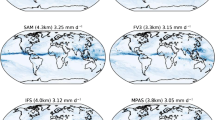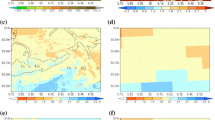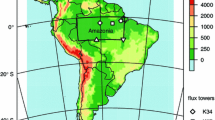Abstract
Impacts of initial conditions on cloud-resolving model simulations are investigated using a series of sensitivity experiments. Five experiments with perturbed initial temperature, moisture, and cloud conditions are conducted and compared to the control experiment. The model is forced by the large-scale vertical velocity and zonal wind observed and derived from NCEP/Global Data Assimilation System (GDAS). The results indicate that model predictions of rainfall are much more sensitive to the initial conditions than those of temperature and moisture. Further analyses of the surface rainfall equation and the moisture and cloud hydrometeor budgets reveal that the calculations of vapor condensation and deposition rates in the model account for the large sensitivities in rainfall simulations.
Similar content being viewed by others
References
Bennartz, R., T. Greenwald, C. O’Dell, and A. Heidinger, 2003: Fast passive microwave radiative transfer in precipitating clouds: Towards direct radiance assimilation. 13th, Proc. International TOVS Study Conference, Sainte-Adele, Quebec, Canada, Bureau of Meteorology Research Centre, Melbourne, Australia, 144–151.
Chen, M., R. B. Rood, and J. Joiner, 1999: Assimilating TOVS humidity into the GOES-2 data assimilation system. J. Climate, 12, 2983–2995.
Chou, M.-D., and M. J. Suarez, 1994: An efficient thermal infrared radiation parameterization for use in general circulation model. NASA Tech. Memo. 104606, Vol. 3, 85pp. [Available from NASA/Goddard Space Flight Center, Code 913, Greenbelt, MD 20771.]
Chou, M.-D., D. P. Kratz, and W. Ridgway, 1991: Infrared radiation parameterization in numerical climate models. J. Climate, 4, 424–437.
Chou, M.-D., M. J. Suarez, C.-H. Ho, M. M.-H. Yan, and K.-T. Lee, 1998: Parameterizations for cloud overlapping and shortwave single scattering properties for use in general circulation and cloud ensemble models. J. Atmos. Sci., 55, 201–214.
Cui, X., and X. Li, 2006: Role of surface evaporation in surface rainfall processes. J. Geophys. Res., 111, D17112, doi:10.1029/2005JD006876.
Derber, J. C., and W.-S. Wu, 1998: The use of TOVS cloud-cleared radiances in the NCEP SSI analysis system. Mon. Wea. Rev., 126, 2287–2299.
Gao, S., 2008: A three dimensional dynamic vorticity vector associated with tropical oceanic convection. J. Geophys. Res., 113, doi: 10.1029/2006JD008247.
Gao, S., F. Ping, X. Li, and W.-K. Tao, 2004: A convective vorticity vector associated with tropical convection: A two-dimensional cloud-resolving modeling study. J. Geophys. Res., 109, D14106, doi:10.1029/2004JD004807.
Gao, S., X. Cui, Y. Zhu, and X. Li, 2005a: Surface rainfall processes as simulated in a cloud resolving model. J. Geophys. Res., 110, D10202, doi: 10.1029/2004JD005467.
Gao, S., X. Cui, Y. Zhou, X. Li, and W.-K. Tao, 2005b: A modeling study of moist and dynamic vorticity vectors associated with 2D tropical convection. J. Geophys. Res., 110, D17104, doi:10.1029/2004JD005675.
Gao, S., L. Ran, and X. Li, 2006: Impacts of ice microphysics on rainfall and thermodynamic processes in the tropical deep convective regime: A 2D cloudresolving modeling study. Mon. Wea. Rev., 134, 3015–3024.
Gao, S., Y. Zhou, and X. Li, 2007: Effects of diurnal variations on tropical equilibrium states: A two-dimensional cloud-resolving modeling study. J. Atmos. Sci., 64, 656–664.
Gelaro, R., C. A. Reynolds, R. H. Langland, and G. D. Rohaly, 2000: A predictability study using geostationary satellite wind observations during NORPEX. Mon. Wea. Rev., 128, 3789–3807.
Grabowski, W. W., X. Wu, M. W. Moncrieff, and W. D. Hall, 1998: Cloud-resolving model of tropical cloud systems during Phase III of GATE. Part II: Effects of resolution and the third spatial dimension. J. Atmos. Sci., 55, 3264–3282.
Grody, N., J. Zhao, R. Ferraro, F. Weng, and R. Boers, 2001: Determination of precipitable water and cloud liquid water over oceans from the NOAA 15 advanced microwave sounding unit. J. Geophys. Res., 106,D3, 2943–2953.
Khairoutdinov, M. F., and D. A. Randall, 2003: Cloud resolving modeling of the ARM summer 1997 IOP: Model formulation, results, uncertainties, and sensitivities. J. Atmos. Sci., 60, 607–625.
Krueger, S. K., Q. Fu, K. N. Liou, and H.-N. S. Chin, 1995: Improvement of an ice-phase microphysics parameterization for use in numerical simulations of tropical convection. J. Appl. Meteor., 34, 281–287.
Leslie, L. M., J. F. Le Marshall, R. P. Morison, C. Spinoso, R. J. Purser, N. Pescod, and R. Seecamp, 1998: Improved hurricane track forecasting from the continuous assimilation of high quality satellite wind data. Mon. Wea. Rev., 126, 1248–1257.
Li, J., W. W. Wolf, W. P. Menzel, W. Zhang, H.-L. Huang, and T. H. Achtor, 2000: Global soundings of the atmosphere from ATOVS measurements: The algorithm and validation. J. Appl. Meteor., 39, 1248–1268.
Li, X., C.-H. Sui, K.-M. Lau, and M.-D. Chou, 1999: Large-scale forcing and cloud-radiation interaction in the tropical deep convective regime. J. Atmos. Sci., 56, 3028–3042.
Li, X., C.-H. Sui, and K.-M. Lau, 2002a: Dominant cloud microphysical processes in a tropical oceanic convective system: A 2-D cloud resolving modeling study. Mon. Wea. Rev., 130, 2481–2491.
Li, X., C.-H. Sui, and K.-M. Lau, 2002b: Interactions between tropical convection and its environment: An energetics analysis of a 2-D cloud resolving simulation. J. Atmos. Sci., 59, 1712–1722.
Li, X., S. Zhang, and D.-L. Zhang, 2006: Thermodynamic, cloud microphysics and rainfall responses to initial moisture perturbations in the tropical deep convective regime. J. Geophys. Res., 111, D14207, doi:10.1029/2005JD006968.
Lin, Y.-L., R. D. Farley, and H. D. Orville, 1983: Bulk parameterization of the snow field in a cloud model. J. Climate Appl. Meteor., 22, 1065–1092.
McNally, A. P., J. C. Derber, W.-S. Wu, and B. B. Katz, 2000: The use of TOVS level-1B radiances in the NCEP SSI analysis system. Quart. J. Roy. Meteor. Soc., 126, 689–724.
Ping, F., Z. Luo, and X. Li, 2007: Microphysical and radiative effects of ice microphysics on tropical equilibrium states: A two-dimensional cloud-resolving modeling study. Mon. Wea. Rev., 135, 2794–2802.
Rutledge, S. A., and P. V. Hobbs, 1983: The mesoscale and microscale structure and organization of clouds and precipitation in midlatitude cyclones. Part VIII: A model for the “seeder-feeder” process in warm-frontal rainbands. J. Atmos. Sci., 40, 1185–1206.
Rutledge, S. A., and P. V. Hobbs, 1984: The mesoscale and microscale structure and organization of clouds and precipitation in midlatitude cyclones. Part XII: A disgnostic modeling study of precipitation development in narrow cold-frontal rainbands. J. Atmos. Sci., 41, 2949–2972.
Soong, S. T., and Y. Ogura, 1980: Response of tradewind cumuli to large-scale processes. J. Atmos. Sci., 37, 2035–2050.
Soong, S. T., and W. K. Tao, 1980: Response of deep tropical cumulus clouds to mesoscale processes. J. Atmos. Sci., 37, 2016–2034.
Sui, C.-H., K.-M. Lau, W.-K. Tao, and J. Simpson, 1994: The tropical water and energy cycles in a cumulus ensemble model. Part I: Equilibrium climate. J. Atmos. Sci., 51, 711–728.
Sui, C.-H., X. Li, and K.-M. Lau, 1998: Radiativeconvective processes in simulated diurnal variations of tropical oceanic convection. J. Atmos. Sci., 55, 2345–2359.
Sui, C.-H., X. Li, M.-J. Yang, and H.-L. Huang, 2005: Estimation of oceanic precipitation efficiency in cloud models. J. Atmos. Sci., 62, 4358–4370.
Tao, W.-K., and J. Simpson, 1993: The Goddard cumulus ensemble model. Part I: Model description. Terr. Atmos. Oceanic Sci., 4, 35–72.
Tao, W.-K, J. Simpson, and M. McCumber, 1989: An icewater saturation adjustment. Mon. Wea. Rev., 117, 231–235.
Tao, W.-K., J. Simpson, C.-H. Sui, C.-L. Shie, B. Zhou, K.-M. Lau, and M. W. Moncrieff, 1999: Equilibrium states simulated by cloud-resolving models. J. Atmos. Sci., 56, 3128–3139.
Tao, W.-K., C.-L. Shie, J. Simpson, S. Braun, R. H. Johnson, and P. E. Ciesielski, 2003: Convective systems over the South China Sea: Cloud-resolving model simulations. J. Atmos. Sci., 60, 2929–2956.
Tao, W.-K., D. Johnson, C.-L. Shie, and J. Simpson, 2004: The atmospheric energy budget and large-scale precipitation efficiency of convective systems during TOGA COARE, GATE, SCSMEX, and ARM: Cloud-resolving model simulations. J. Atmos. Sci., 61, 2405–2423.
Wang, J.-J., X. Li, and L. Carey, 2007: Evolution, structure, cloud microphysical and surface rainfall processes of a monsoon convection during the South China Sea Monsoon Experiment. J. Atmos. Sci., 64, 360–380.
Wentz, F. J., C. Gentemann, D. Smith, and D. Chelton, 2000: Satellite measurements of sea surface temperature through clouds. Science, 288, 847–850.
Xiao, Q., X. Zou, M. Pondeca, M. A. Shapiro, and C. Velden, 2002: Impacts of GMS-5 and GOES-9 satellite-derived winds on the prediction of a NORPEX extratropical cyclone. Mon. Wea. Rev., 130, 507–528.
Xu, K.-M., and Coauthors, 2002: An intercomparison of cloud resolving models with the Atmospheric Radiation Measurement summer 1997 Intensive Observation Period data. Quart. J. Roy. Meteor. Soc., 128, 593–624
Xu, X., F. Xu, and B. Li, 2007: A cloud-resolving modeling study of a torrential rainfall event over China. J. Geophys. Res., 112, D17204, doi: 10.1029/2006JD008275.
Zhu, T., D.-L Zhang, and F. Weng, 2002: Impact of the Advanced Microwave Sounding Unit measurements on hurricane precition. Mon. Wea. Rev., 130, 2416–2432.
Author information
Authors and Affiliations
Corresponding author
Rights and permissions
About this article
Cite this article
Gao, S., Li, X. Impacts of initial conditions on cloud-resolving model simulations. Adv. Atmos. Sci. 25, 737–747 (2008). https://doi.org/10.1007/s00376-008-0737-6
Received:
Revised:
Published:
Issue Date:
DOI: https://doi.org/10.1007/s00376-008-0737-6




